The America’s Cup is sailing’s pinnacle contest, a 182-year-old sporting challenge that drives its protagonists to the extremes of technology, money and ego—all for the glory, the power and defense of an ornate silver ewer. The 37th Louis Vuitton America’s Cup will be contested in the waters off Barcelona, Spain, in October 2024, when the Defender, Emirates Team New Zealand, faces the risen challenger from the preceding Louis Vuitton Cup round-robins. The Match is one on one, and it’s all in for the Cup.
Click to Navigate
The Defender | The Challengers | The AC75 | The Venue
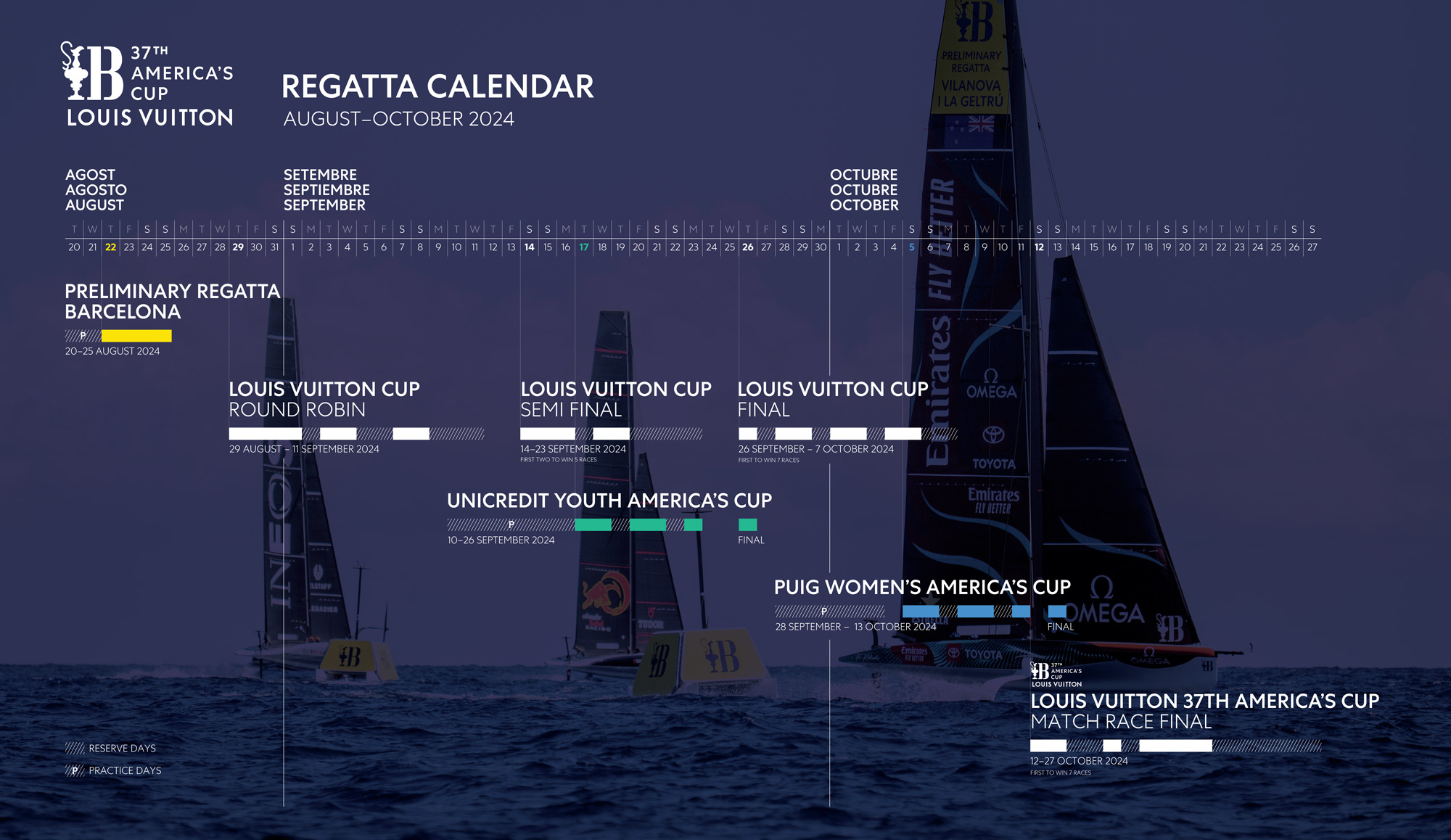
Time Frame: August 29 to October 7, 2024
With the official opening of the America’s Cup Village in Barcelona on August 22, 2024, racing of the Louis Vuitton Round Robins gets underway in the second-generation AC75s. From the Round-Robin stage, four Challengers will advance to a Semi-final series before the top two teams qualify for the Final stage. The winner will be the first Challenger in the Louis Vuitton Cup Final, from September 26 to October 7. The first team to win seven races advances to the 37th America’s Cup Match.
Time Frame: October 2024
The America’s Cup Match, raced in custom and highly developed AC75 Class yachts, is a one-on-one contest raced under mutually accepted racing rules. The winner of each race scores one point, the loser scores zero. The first team to score 7 points wins the America’s Cup and becomes the Defender of the 38th edition.
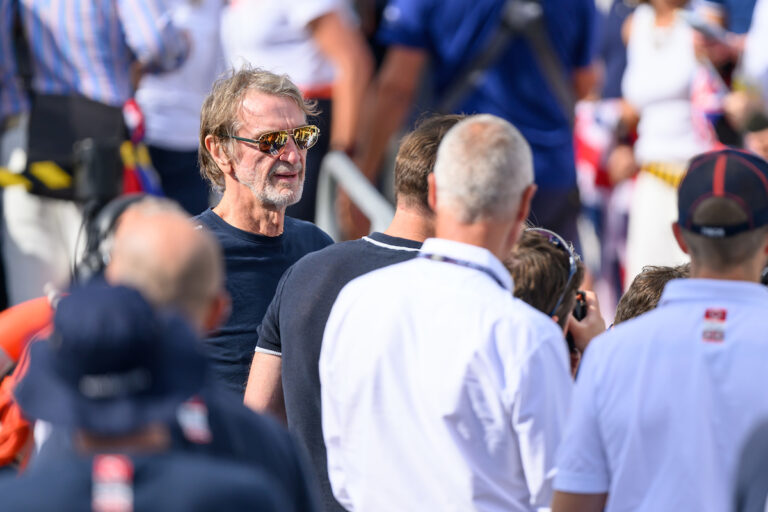
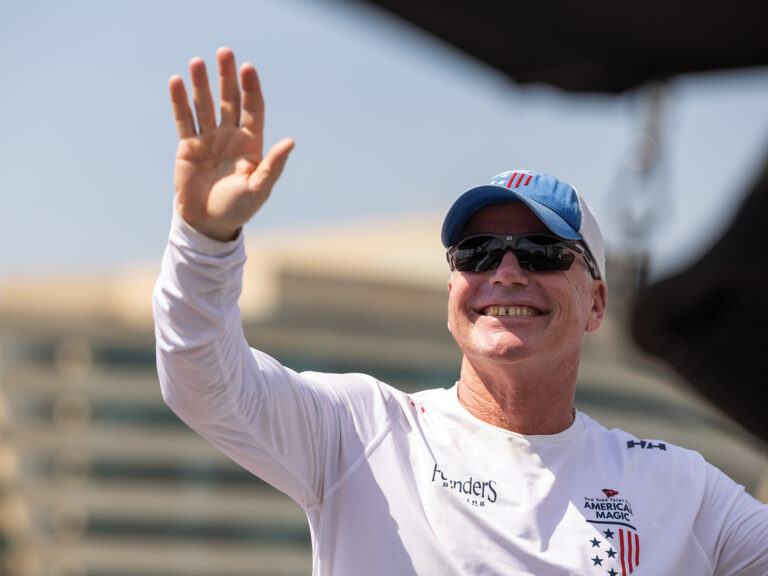
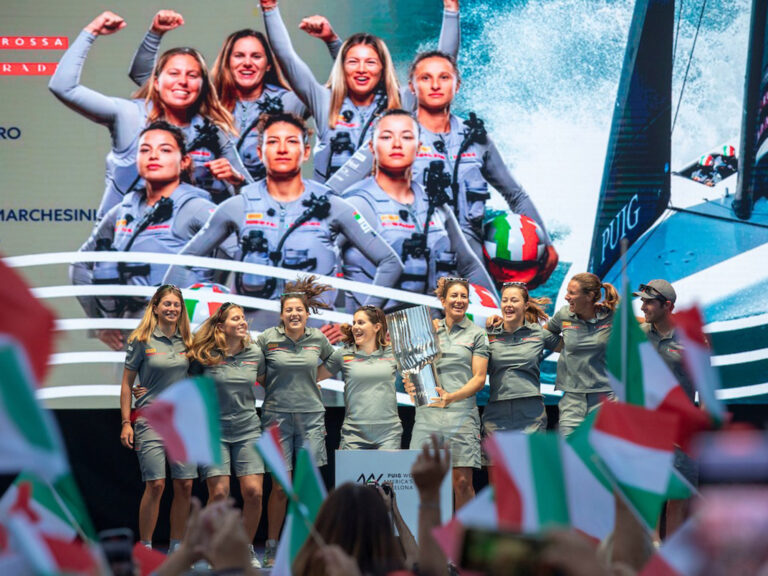
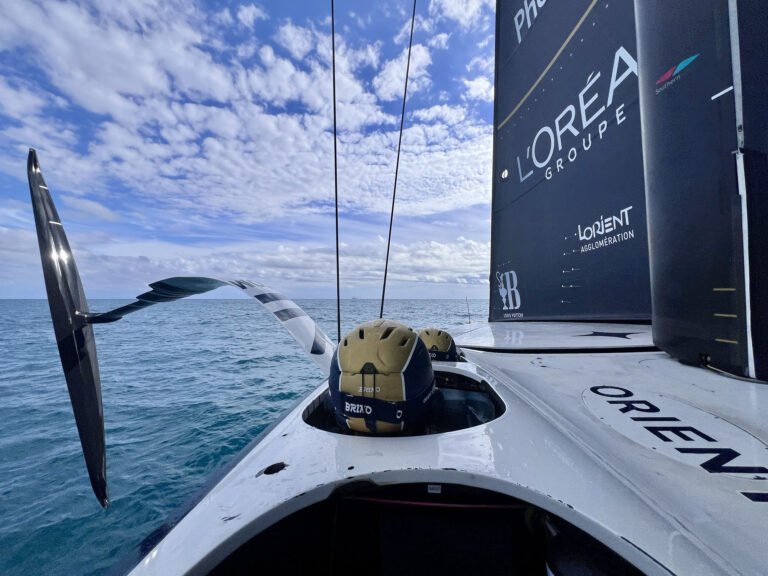
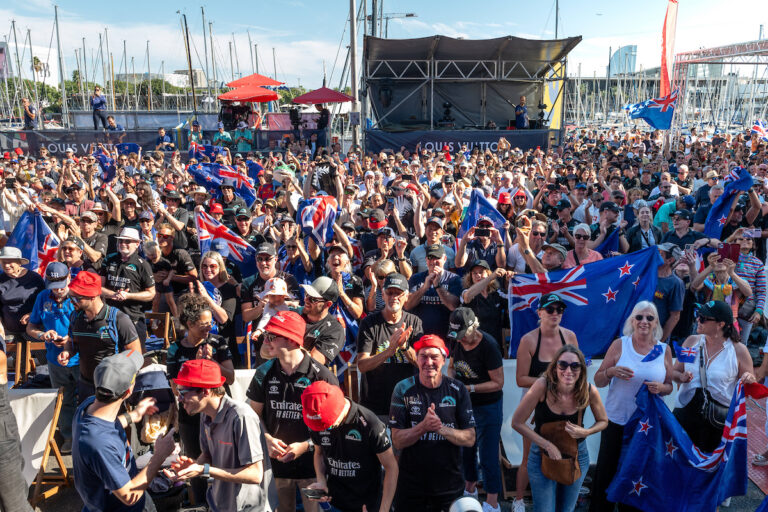
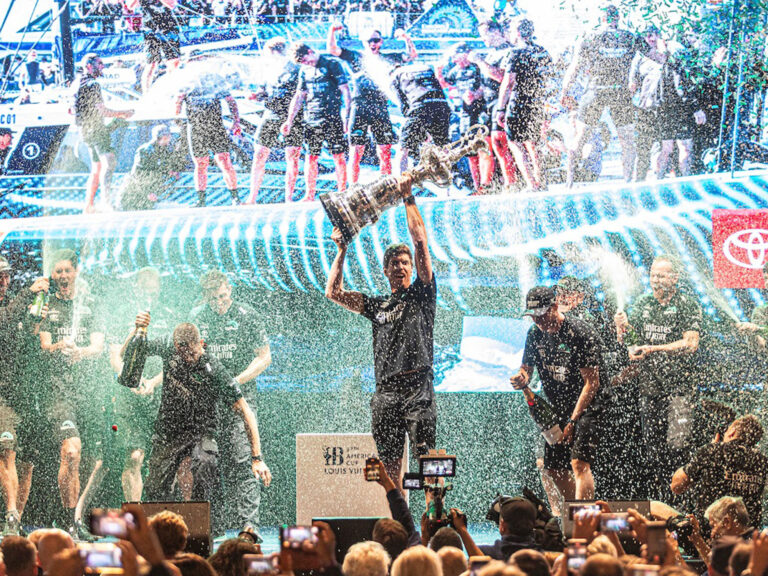
Emirates Team New Zealand – Royal New Zealand Yacht Squadron
Today, Emirates Team New Zealand are ubiquitous with the America’s Cup. Winners of the Cup Match on their home waters of Auckland Harbor in 2021, the defenders have been the Cup’s modern-day juggernaut since first winning in San Diego in 1995. Their defense in 2000 was decisive, but they were then soundly beaten in 2003, and were failed challengers in 2007 and 2013. In 2017, with clever use of cyclors to power their AC50 catamarans, and a storybook rise from the ashes following a destructive capsize, Team New Zealand regained its Defender role in Bermuda in spectacular fashion.
The Italians of Luna Rossa Prada Pirelli were kids play for the powerful Team New Zealand operation in the 36th Cup Match Auckland in 2021, but following another successful defense, the New Zealand tax payers balked at the cost and burden of hosting another match and the divorce was messy. Grant Dalton, the team’s legendary CEO and face of New Zealand yachting put the regatta out to bid and secured the iconic Spanish city of Barcelona as a proper Mediterranean venue that would be more attractive to would-be European challengers on the fence. He was right.
As Defender, Team New Zealand dictates the terms of the boat and the Match and therefore has the theoretical advantage when it comes to the regatta’s execution, as well as the upper hand with the development of the high-tech AC75 class. This contributes to their power as the defender, but the
America’s Cup is won as much by the respective design teams as it is by the sailors on the water. It’s a design and development challenge, and historically the faster boat always wins. Still, the sailors are a unique breed, with very few of the America’s Cup drivers able to claim the experience of those at the helms.
For Team New Zealand, its primary helmsman Peter Burling, two-time Cup winner and Olympic gold medalist, is freakishly cool under pressure, technically minded and arguably the best high-performance helmsman on the planet. Because the helmsmen, or any crew for that matter, no longer crosses the AC75 during maneuvers, Burling’s equal in the offside cockpit is Cup veteran Nathan Outteridge, of Australia—also an Olympic Gold and Silver medalist. Long the team to emulate and beat, and always one step ahead, this New Zealand defense will be its sharpest yet.
Click the team’s logo to read more
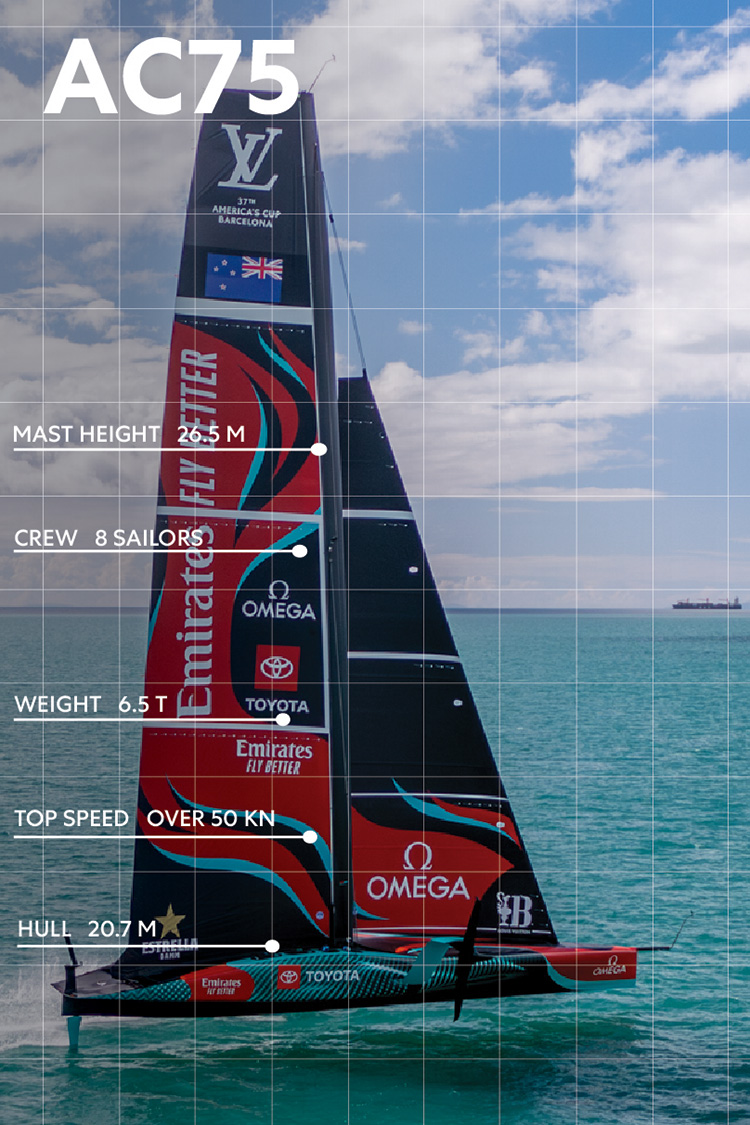 The AC75 Class, which will be used for the 37th America’s Cup, was first developed in 2018, ahead of the 36th edition in Auckland. Following on the AC72 catamarans of San Francisco and the AC50s of Bermuda, the AC75 class was a return to monohull racing, but first time ever with foils, marking a dramatic push in technology in hull shape and design, hydrodynamics, aerodynamics, mechatronics and especially foil and sail control development.
The AC75 Class, which will be used for the 37th America’s Cup, was first developed in 2018, ahead of the 36th edition in Auckland. Following on the AC72 catamarans of San Francisco and the AC50s of Bermuda, the AC75 class was a return to monohull racing, but first time ever with foils, marking a dramatic push in technology in hull shape and design, hydrodynamics, aerodynamics, mechatronics and especially foil and sail control development.
The variety of platforms revealed in Auckland with the first generation demonstrated the narrow performance parameters faced by each team’s army of designers and engineers. With such a long regatta window there is a high likelihood of light and strong winds, an impossible task is to deliver a boat that’s both quick to take off, highly maneuverable in the confined boundaries of the racecourse, and of course, reliable.
In the previous Cup teams were allowed to build two AC75s, but for Barcelona they were only allowed to build one, putting greater pressure on the design team to deliver a winning package on the first go. With an updated AC75 Class Rule, the boats are expected to be quite advanced from Version 1, with larger foil allowances to promote earlier takeoff and improved handling in the rougher sea state expected off Barcelona. The boats will be lighter and onboard, the electronics, hydraulics and software systems (collectively referred to as mechatronics) will be vastly improved for more precise control of foils, foil flaps and more.
An important change is the crew allotment, which has been reduced to only eight sailors on board. With two helmsmen in opposite cockpits flanked by mainsail trimmers, and opposite side flight controllers that leaves two to power the hydraulic systems to manipulate the sails of the boat. All foil adjustments are powered by onboard battery banks. Several of the elements are strictly one-design, such as the foil arms and hydraulics, but the areas of innovation elsewhere are virtually limitless.
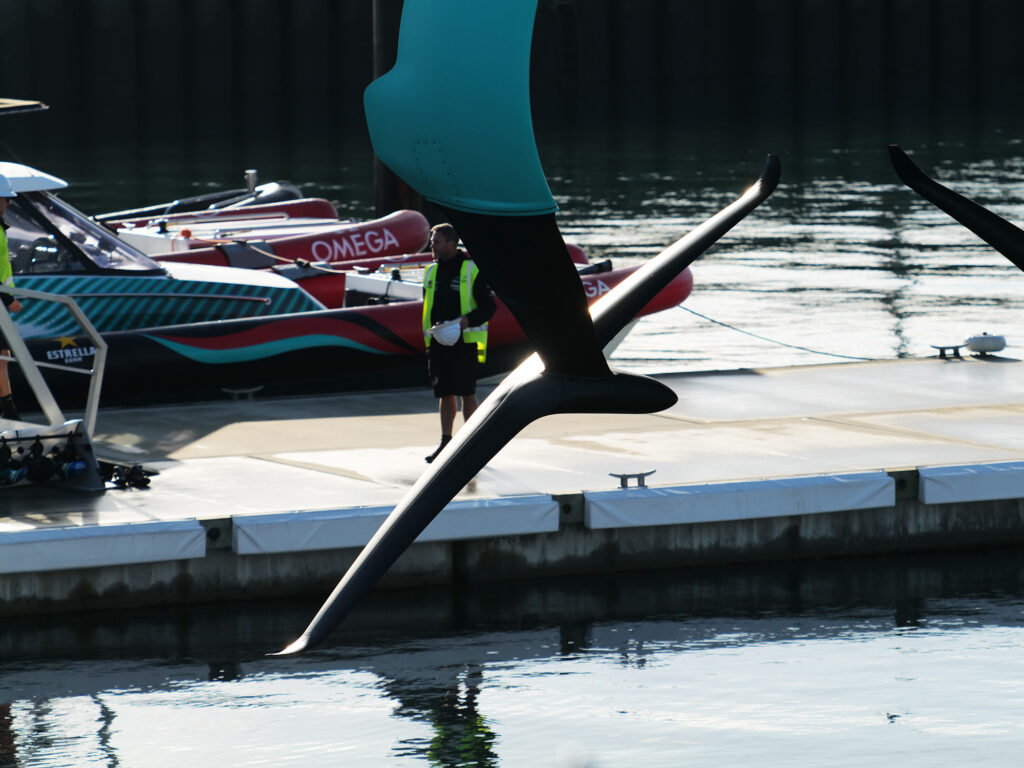
Restrictions on the number of foils allowed to be built, and the time to build them, has put a premium on ensuring the right foil package is signed off ahead of the Cup. A wide variety of wing flaps, tips and bulbs have been explored, with the goal being low drag and stable flight across
a range of conditions. Dynamic manipulation of the foil wings and foil attitude are essential to maneuvers and flight, and within the foils and foil arms themselves are the mechatronics that make the difference. The new-generation foils are considerably larger than the version 1 foils of the AC75 rule used in the previous America’s Cup edition, in order to promote quicker lift and faster flight.
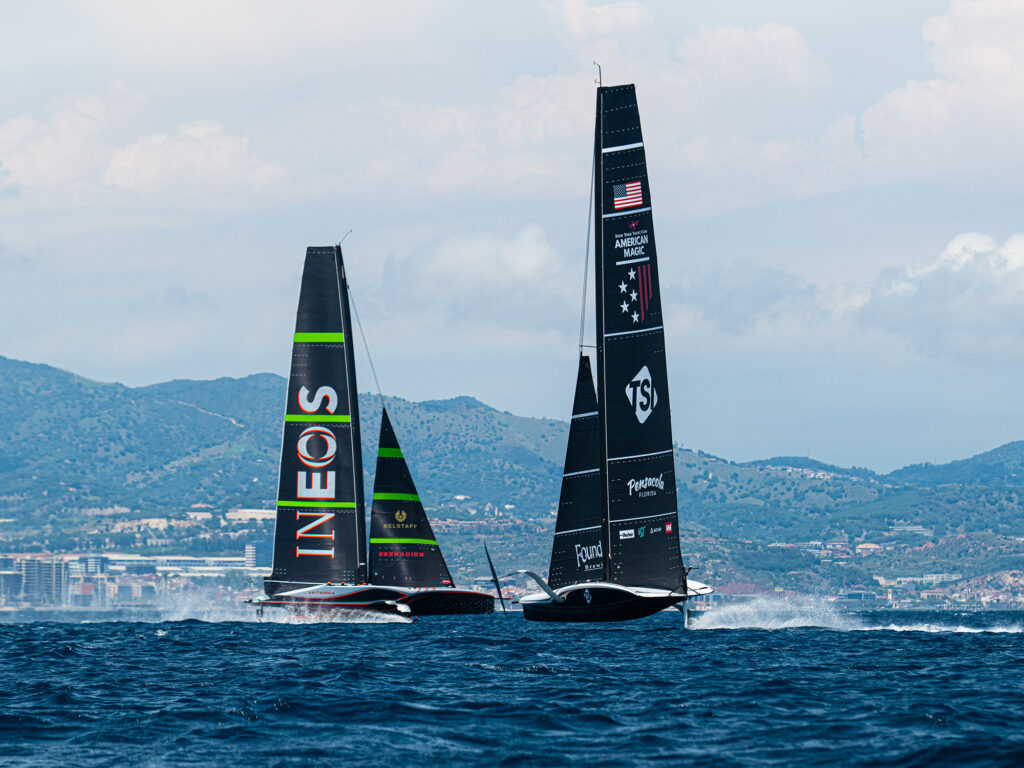
With the second-generation AC75s, it was anticipated that hulls would be similar, but the results have been anything but that. The balance of designing a hull that is hydrodynamically superior in the water and aerodynamically slippery in flight is a delicate one. Bustles, or skegs, that run the length of the hull prevent leeway during the takeoff phase and provide an endplate effect to the water. Within constraints of the design rules there are tradeoffs of volume, area and much more.
It is said that the AC75 hull itself is merely a platform to hold the sails and the sailors, but once in flight, it is the foils that will make or break the campaign. “There are still areas of these boats where significant gains can be found,” says Dan Bernasconi of Emirates Team New Zealand. “The larger span of the foils creates a lot of avenues for the design teams to run through and things like the mainsail control system, the opening up of the hydraulics, rule and the lighter weight of the boats makes for some interesting structural decisions to be made.”
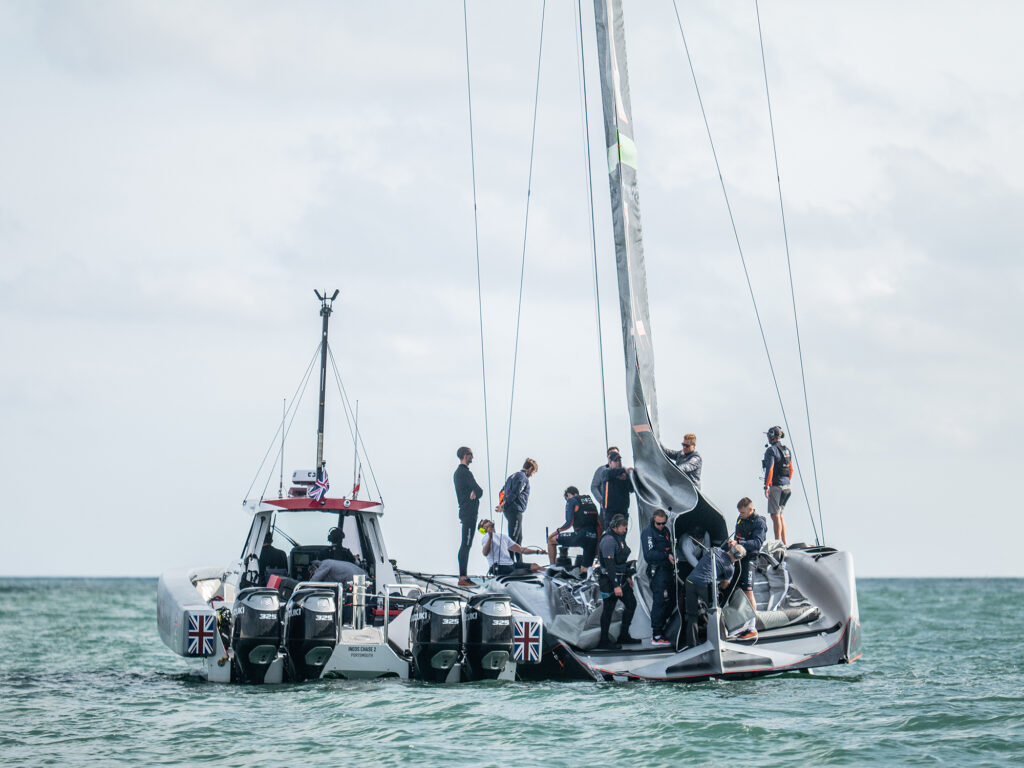
The twin-skin mainsail system developed with the Version 1 AC75s remains, as does self-tacking jibs. There will be no downwind sails as the angles are high and fast, upwind virtually similar to downwind with the apparent wind so far forward. The concept of the double-skinned mainsail is to be able to manipulate each skin independently in order to power the sails for takeoff and depower them when in flight. Jibs are treated as any other monohull inventory: J1, J2, J3, respectively as the wind builds the jibs get smaller.
These jibs can be dynamically shaped with hydraulic leech and lead controls operated remotely. With each adjustment—and there are many simultaneously—power is pulled from the hydraulic reserves, which are re-pressurized by the continuous and high levels of wattage produced by the cyclors. Also of consideration is the manipulation of the mast tube itself, batten characteristics, and the intricate hydraulic systems that exist between the skins.
Barcelona, Spain
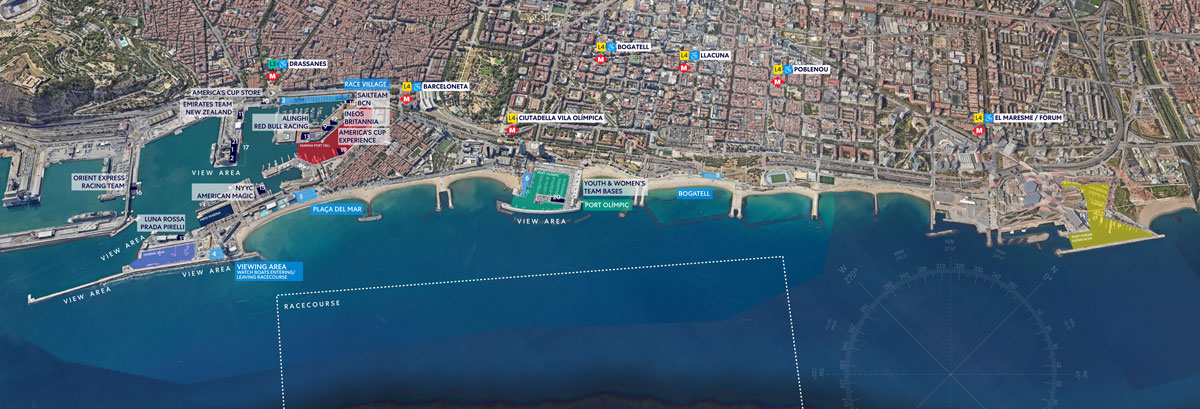
Port Vell in downtown Barcelona, will host the America’s Cup activities and bases. The event Race Village will be located along Moll de la Fusta and will allow a free experience accessible for everyone, connecting people to the boats, the teams and the event itself with multiple activations, live screens and stages. Walking around the Port Vell and looking across the harbor, spectators can see the team bases and their inner workings up close.
Emirates Team New Zealand, holders of the America’s Cup, selected their base on the corner area on the promontory that leads out to the World Trade Centre where the Media Centre and America’s Cup Event offices are housed. INEOS Britannia and Alinghi Red Bull Racing are both housed with the superyacht harbor out to the south and the Real Club Nàutic de Barcelona Yacht Club looking out on the waterfront of the downtown district.
Luna Rossa Prada Pirelli and NYYC American Magic opted for bases further around the port on its southern flank. The Orient Express Racing Team is based on the Moll de Ponent near the bridge to the commercial docks. The racing itself will take place on the America’s Cup race course just yards off the beachfront of the La Barceloneta offering ample opportunity for spectators to watch the racing all along the beachfront.
Royal Yacht Squadron Ltd.
English yachting has had a score to settle since 1851 and once again, the responsibility to make good on that is on the broad shoulders of four-time Olympic gold medalist, helmsman and INEOS Britannia CEO, Sir Ben Ainslie. Plenty of Brits have tried and failed before—the likes of Lord Dunraven, Sir Thomas Lipton and Sir T.O.M. Sopwith among them—and since returning to the Cup stage in Bermuda in 2017 under Ainslie’s hand, the British challenges continue to come up well short of expectations.
As a syndicate to be dismissed from the Challenger Series early in both Bermuda and Auckland, it was conservatism within the culture that has borne designs that both underperformed and underwhelmed. And while some syndicate backers would walk away, INEOS Britannia bankroller Sir James Ratcliffe knows no quit. There’s plenty in his kitty. As the first to deliver a challenge to Emirates Team New Zealand in Auckland, the INEOS commitment was clear: as Challenger of Record, they bear the burden of representing the interests of all challengers, friends and foes.
While the details of the 37th Cup Match were ironed, INEOS design team soldiered on with its AC development, gaining powerful backing from the Formula 1 engineers of Mercedes-AMG Petronas. As part of the larger INEOS Sports Group, they have tapped into the top-tier cycling realm as well, a boost to the development of its power team of cyclors. Most of the sailing team from Auckland remains intact and this experience will parlay as a strength should the designers and engineers of the sporting juggernaut produce a weapon worthy of the Cup this time. Ainslie’s offside helmsman is by Giles Scott, a double gold-medalist himself, and key sailor of AC36 alongside, sail and foil trimmers Iain Jensen, Luke Parkinson, Leigh MacMillan, Bleddyn Mon, Freddie Carr and Ben Cornish.
In the first year of its campaign INEOS Britannia went straight to the development of foils and control systems with the use of a prototype laden with thousands of sensors. The prototype, referred to in the rules as an “LEQ” (less than or equal to 12 meters in length) was a hint at a more aggressive and simulated approach to the science project that is its AC75. Their AC75, Britannia, is the most aggressive of the new fleet.
New York Yacht Club
The New York Yacht Club’s loss of the America’s Cup in 1983 to the Australia II Syndicate not only ended the club’s 132-year winning streak, but it forever changed the trajectory of the storied international regatta. Rhode Island Sound was no longer the promised land of Cup dreams as the Auld Mug then traveled the globe with each successive Defense: Perth, Australia, San Diego, Valencia, Spain, San Francisco, Bermuda, Auckland, and now Barcelona.
This nagging vacancy in the Club’s trophy collection finally spurred the New York YC’s return to the Cup game with the 36th edition in Auckland. With an early start to the campaign, sufficient funding and a sailing team that lacked nothing, the American challenger arrived in Auckland with confidence and an AC75 known to be slow in lighter winds.
After struggling to collect points in early light-wind races of the Challenger Series, the American team led by helmsman Dean Barker, were on a climb until one dramatic and fatal capsize scuttled all chances of emerging victorious from the Challenger Series. Theirs was an early exit of a formidable team, servers full of data and an AC75 platform that had yet to show its potential—all ingredients for a return and a shot at redemption. Terry Hutchinson, now leader of the squad from onboard a chase boat, retained his key sailing team talent in co-helmsman Paul Goodison, flight controller Andrew Campbell, and others and then doubled down with the hiring of the supremely talented Australian helmsman, Tom Slingsby.
While other teams invested in prototype development, American Magic got right back to business on its rebuilt AC75 Patriot in 2023, staging its operations out of Pensacola, Florida, and logging maximum days and hours on the water before relocating to Barcelona in the summer of 2024 and settling in for the long haul toward the Cup in October.
With the backing of returning principals Hap Fauth and Doug Devos, as well as a strong portfolio of sponsors and partners, there is a greater sense this time around that American Magic is all-in, and then some. Should they lose, it will not be their last challenge. And should they win, it will be the beginning of “American sailing excellence.” With a look to this future, much effort has been put into procuring and grooming young American talent with the likes of Harry Melges IV and trimmers Riley Gibbs and Michael Menninger, both in their late 20s.
For the power team whose task it is to push and pressurize hydraulic juice throughout the boat (these crewmembers are known as cyclors in modern Cup parlance) American Magic has sought out domestic freaks of nature capable of extreme and sustained wattage production. Among those rotating between races will be top cyclists, rowers, kayakers and triathletes. The power team is strong, the sailing team top shelf, so all that’s left to bear is the design team and a new-look Patriot.
Circolo Della Vela Sicilia
The Italian syndicate, led by its founding patron Patrizio Bertelli, entered the America’s Cup club in 2000 and has challenged for the Auld Mug now seven times, ascending through the Prada Cup Challengers Series and into the Match in Auckland only to be soundly beaten by Team New Zealand 7 to 3.
The final score belies the performance of the Italian team at the time. Its innovative AC75 and foil quiver made them plenty quick, and with the shared helming duties between Cup veteran Jimmy Spithill and Francesco Bruni they were formidable opponents for the New Zealanders. Like American Magic, however, the Luna Rossa team departed Auckland with an undeniable motivation of an unfulfilled campaign. There was no doubt they would be back for the 37th.
While Challenger of Record INEOS Britannia and Emirates Team New Zealand worked out the particulars of the 37th America’s Cup Protocol, the Italians promptly regrouped at the team’s base in Cagliari, Italy, and were first to launch their LEQ development boat in October of 2022, an intriguing platform that caught every Cup watcher’s attention.
The prototype’s launch was “the real kick off,” for the campaign, said team director and skipper Max Sirena at the time. “Beyond the technical use of the boat, this prototype also allowed us to restart the campaign in the right gear and team-up immediately, which is essential when you change so many people in different departments.” In Cagliari over the past two years they’ve put in maximum sailing hours on the LEQ and the AC40, racking up servers full of data to produce an AC75 that is both weapon and art. The metallic silver yacht was fast on Day One, and the recon teams assigned to them over the spring reported fast development and a serious sense of purpose.
Société Nautique De Genève
Swiss businessman and team owner Ernesto Bertarelli, a high-performance sailor himself, has been sitting on the sidelines of the America’s Cup waiting for the opportunity to avenge his Alinghi team’s loss to the giant trimaran of Oracle Team USA in the lopsided Deed of Gift Match of 2001.
Alinghi, a professional sailing team since 1994, are two-time winners of the Cup in—in 2003 and 2007. It therefore came as no surprise when they seized the opportunity to rejoin the Cup in Barcelona, much closer to its home base in Geneva as well as the technical base of Red Bull’s Formula 1 headquarters in the UK, where its designers and engineers are now closely aligned with the sailing operation under the powerhouse Red Bull brand. Bertarelli has said they are equal partners, well-funded, and rich with data.
As allowed under the rules, Alinghi Red Bull Racing accelerated its learning curve in big foilers with the purchase of Emirates Team New Zealand’s winning AC75 from 2021. Promptly assembling the crème of its Swiss sailing talent and endurance athlete pool, the team began training with its decorated primary helmsman Arnaud Psarofaghis in early 2022.
“While keeping the winning spirit that has always animated Alinghi, we want for this challenge to do something totally different, totally new, totally fresh,” Bertarelli said at the team’s challenge announcement in December 2021. “When we imagined with Dietrich Mateschitz the involvement of Red Bull in the America’s Cup, he said: Our way is not to get into the sport as sponsors, but to blend into the team, to form a true partnership, to nurture young athletes and turn them into the best in their field. He also proposed that we should make contributions to give the America’s Cup itself a new dimension.”
What that dimension will be revealed in due time, but until then, the strength and depth of the Alinghi Red Bull Racing sailing team will not be underestimated by challengers or Defender alike. The hiring of former American Magic skipper Dean Barker, the most experienced Cup skipper in the field, is a boost and a wealth of Cup knowledge that will serve the team well with regard to its AC75 which has been at pace since its first sailing day.
Even with a dismasting in June of 2023, the team did not miss a beat and was sailing within weeks, a sign of depth of the team behind the scenes and the wherewithal to let nothing stop them from advancing to the Cup match.
Société Nautique Saint-Tropez
Last to the dance, but no stranger to the America’s Cup dancefloor are the French, this time branded as the Orient Express Racing Team and officially announced in February of 2023. As a late arrival to the Challenger fleet, the French have taken a development fast track with an AC75 design package provided by Emirates Team New Zealand, a starting point from which they could develop their own refined platform and foil concepts.
The sport of sailing in France enjoys an ardent following and a marine industry with a reputation for building most of the world’s best high-performance race boats. While their AC75 was under build in France, the first year of their campaign was focused on AC40 development and simulator training, and once their AC75 was launched in early summer, they were quick to get it up to speed.
The America’s Cup Recon team assigned to the French operation reported repeated technical issues inside the boat as the sailing team worked through the commissioning phase in early summer, but there were moments of notable pace in straight-line sailing. Sharp maneuvers and reliability had not yet come, but the team was confident both would be solved come race day.
The sailing team is led by Olympic Nacra 17 and SailGP Team France skipper Quentin Delapierre and his offside equal Kevin Peponnet. A podium finish at the first Preliminary Regatta in Vilanova i La Getru in September was a major confidence boost for the young team, which showed up to the regatta with far fewer sailing days in the AC40 than other teams.
Their surprise performance was immediately followed by the announcement of the L’Oréal Groupe as an official sponsor, sure to elevate the team’s national profile and strengthen the foundation of what is touted as an incubator of French sailing technology and talent, capable of winning and defending the America’s Cup in the near future.